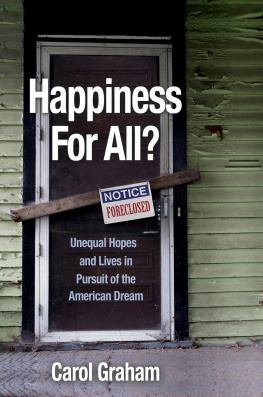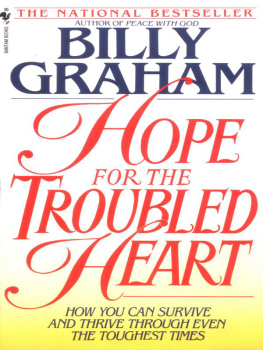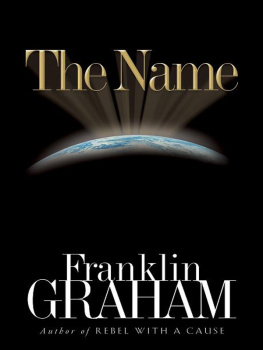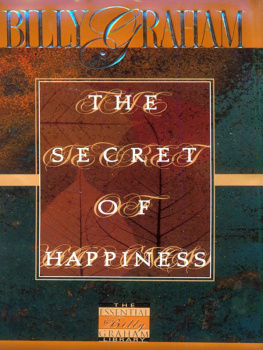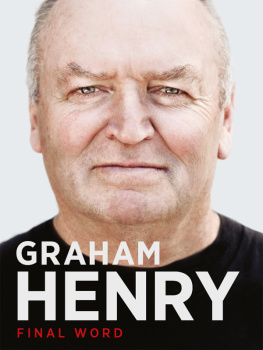Graham - Happiness for All?
Here you can read online Graham - Happiness for All? full text of the book (entire story) in english for free. Download pdf and epub, get meaning, cover and reviews about this ebook. year: 2017, publisher: Princeton University Press, genre: Politics. Description of the work, (preface) as well as reviews are available. Best literature library LitArk.com created for fans of good reading and offers a wide selection of genres:
Romance novel
Science fiction
Adventure
Detective
Science
History
Home and family
Prose
Art
Politics
Computer
Non-fiction
Religion
Business
Children
Humor
Choose a favorite category and find really read worthwhile books. Enjoy immersion in the world of imagination, feel the emotions of the characters or learn something new for yourself, make an fascinating discovery.
Happiness for All?: summary, description and annotation
We offer to read an annotation, description, summary or preface (depends on what the author of the book "Happiness for All?" wrote himself). If you haven't found the necessary information about the book — write in the comments, we will try to find it.
Happiness for All? — read online for free the complete book (whole text) full work
Below is the text of the book, divided by pages. System saving the place of the last page read, allows you to conveniently read the book "Happiness for All?" online for free, without having to search again every time where you left off. Put a bookmark, and you can go to the page where you finished reading at any time.
Font size:
Interval:
Bookmark:

Happiness for All?
Happiness for All?
Unequal Hopes and Lives in Pursuit of the American Dream
Carol Graham
Princeton University Press
Princeton and Oxford
Copyright 2017 by Princeton University Press
Published by Princeton University Press, 41 William Street,
Princeton, New Jersey 08540
In the United Kingdom: Princeton University Press,
6 Oxford Street, Woodstock, Oxfordshire OX20 1TR
press.princeton.edu
Jacket image courtesy of Shutterstock
All Rights Reserved
ISBN 978-0-691-16946-0
Library of Congress Control Number: 2016961394
British Library Cataloging-in-Publication Data is available
This book has been composed in Garamond Premier Pro
Printed on acid-free paper.
Printed in the United States of America
1 3 5 7 9 10 8 6 4 2
Dedication
To Anna, Adrian, and Alexanderthe true source of my hopes and dreams
Contents
CHAPTER 1
INTRODUCTION
Happiness for All: Living the Dream? 1
CHAPTER 2
What Happened to Horatio Alger? U.S. Trends in Inequality and Opportunity in Comparative Perspective 22
CHAPTER 3
Who Believes in the American Dream? Public Attitudes about Mobility in the United States and Beyond 42
CHAPTER 4
The High Costs of Being Poor in the Land of the Dream: Stress, Insecurity, and Lack of Hope 76
CHAPTER 5
Well-Being, Aspirations, and Outcomes: What Do We Know? 120
CHAPTER 6
Can We Save the Dream? 136
Illustrations
Tables
Preface
I present this book with some trepidation. I have spent most of my career studying poverty, inequality, and, more recently, well-being around the world, with a focus on developing economies. Although I grew up partly in the United States (and am a U.S. citizen), I was born in Peru and have a strong grounding in each culture. This is my first large body of work that focuses primarily on the United States. There are many scholars who know much more about U.S. poverty and inequality than I do. Yet what I have been seeing, experiencing, reading, and finding in my data in recent years is too compelling for me to not write about it.
My book is a story of a country divided not only in terms of the distribution of income and opportunity, but also in terms of hopes and dreams. The United States is now much more divided on many fronts than the region where I was born.
Over forty years ago, my father wrote a seminal article in the Archives of Environmental Health titled The High Costs of Being Poor. He and his coauthor documented the higher costs that the poor paid for essential servicessuch as purchasing water from trucks and using kerosene and candles in lieu of electricity. The poor paid roughly fifteen times more per unit on average than the wealthy paid for piped water and electricity, while the services they purchased, such as contaminated water, were clearly inferior. Not surprisingly the health outcomes of their children suffered. Now, those same urban slums where heand later Iconducted research have access to public services and house a burgeoning middle class.
In this book, I focus on the high costs of being poor in the United States, costs that are usually not in the form of material goods or basic services, but in the form of stress, insecurity, and lack of hope. In part this is due to inadequate access to health insurance and stable jobs, and in part it is due to the increasing distancein terms of income, education, and opportunitiesbetween those at the top and bottom of the distribution. As in the case of inferior health outcomes for the children of the poor in Peru in the 1970s, the children of the poor in the United States today inherit insecurity and lack of hope.
There are endless articles and even some books on how unequal the country has become and how fragile the American Dream is. My story is different because of the metrics that I use to tell it. Rather than focusing on Gini coefficients, 90/10 ratios, and/or probabilities of moving up or down the income ladder (and I confess to using all of these terms throughout the book), my central focus is the unequal distribution of hopes, dreams, and expectations for the future, and why this is likely to lead to even more unequally shared outcomes in the future.
Individuals who believe in and have hope for the future invest in it; those who have no such hopes typically do not. Not only are their futures compromised as a result, but so are their childrens. The markers of unequally shared hope in the United States are evident not only in the income, education, and employment data, but also in differences across socioeconomic cohorts in mortality and morbidity, marriage, and incarceration rates and other signs of societal fragmentation. They are even evident in the words that different cohorts use. The vocabulary of the wealthy reflects knowledge acquisition and health-conscious behaviors; that of the poor reflects desperation, short-term outlooks, and patchwork solutions.
This is a deep-seated and difficult problem to solve, and the answers are not obvious. I have no magic bullets to offer. My conclusions highlight the importance of identifying and measuring the extent of the problem. Well-being metrics can play an important role in monitoring trends in quality of life and life experiences, as well as in hope and aspirations on the one hand, and desperation and misery on the other. I also point to policiesincluding many experimental onesthat have improved economic outcomes and lives in general, with the provision of hope being an important channel. Well-being metrics can help in the design and evaluation of such policies. All of this, by definition, is work in progress, and my own research is exploring new kinds of interventions as this book goes to press.
There are a number of people that I must thank for either inspiring my work or commenting on it or both over the years. These include George Akerlof, Jeremy Barofsky, Nancy Birdsall, Gary Burtless, Laurence Chandy, Andrew Clark, Angus Deaton, Steven Durlauf, Richard Easterlin, Clifford Gaddy, Ross Hammond, Andrew Oswald, Jonathan Rauch, Richard Reeves, Jonathan Rothwell, Isabel Sawhill, and Peyton Young. In addition, I was lucky enough to serve on a National Academy of Sciences panel on well-being, and gained a completely new education about the psychological dimensions of well-being measurement from the wonderful scholars on the panel: Laura Carstensen, Danny Kahneman, and Arthur Stone.
I also have to thank Sarah Caro of Princeton University Press for being the best editor ever; she was absolutely critical to my Happiness Around the World book in 2009, and then helped inspire this one. I am also grateful to Hannah Paul at the press for her invaluable help, and to two anonymous reviewers for the very constructive comments. I also thank Jenny Wolkowicki and Joseph Dahm for careful and invaluable editorial assistance. At Brookings, a number of people have been essential to supporting my research on unusual topics and giving me confidence in doing so, as well as providing financial and administrative backing. These include Strobe Talbott, Charlotte Baldwin, Steve Bennett, Kim Churches, Kemal Dervis, Yamillet Fuentes, Martin Indyk, Homi Kharas, Aki Nemoto, Kristina Server, and Jen Banks. Finally, I could not have survived the past few years or written this book without the excellent research assistance and collaboration of Soumya Chattopadhyay, Milena Nikolova, Sergio Pinto, and Julia Ruiz-Pozuelo.
CHAPTER 1
Introduction
Happiness for All: Living the Dream?
Life should be better and richer and fuller for everyone, with opportunity for each according to ability and achievement regardless of social class or circumstances at birth.
Next pageFont size:
Interval:
Bookmark:
Similar books «Happiness for All?»
Look at similar books to Happiness for All?. We have selected literature similar in name and meaning in the hope of providing readers with more options to find new, interesting, not yet read works.
Discussion, reviews of the book Happiness for All? and just readers' own opinions. Leave your comments, write what you think about the work, its meaning or the main characters. Specify what exactly you liked and what you didn't like, and why you think so.

